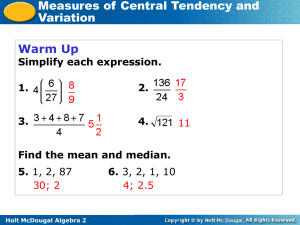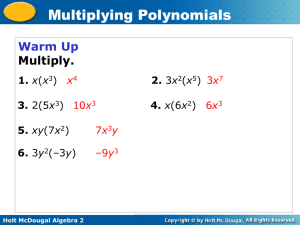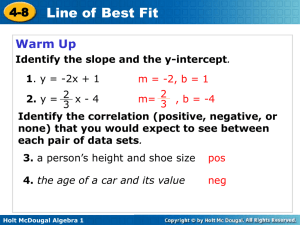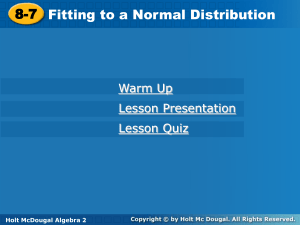Notes 1.1 - Collins Hill High School
advertisement
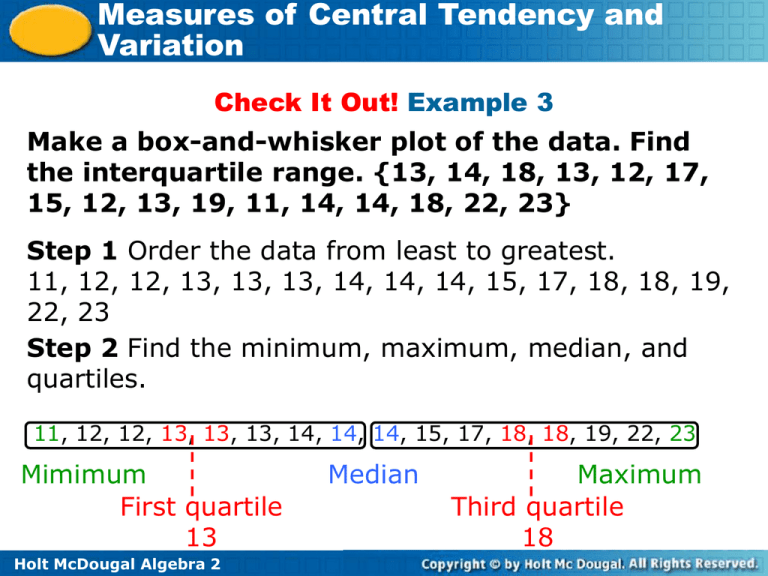
Measures of Central Tendency and
Variation
Check It Out! Example 3
Make a box-and-whisker plot of the data. Find
the interquartile range. {13, 14, 18, 13, 12, 17,
15, 12, 13, 19, 11, 14, 14, 18, 22, 23}
Step 1 Order the data from least to greatest.
11, 12, 12, 13, 13, 13, 14, 14, 14, 15, 17, 18, 18, 19,
22, 23
Step 2 Find the minimum, maximum, median, and
quartiles.
11, 12, 12, 13, 13, 13, 14, 14, 14, 15, 17, 18, 18, 19, 22, 23
Mimimum
First quartile
13
Holt McDougal Algebra 2
Median
Maximum
Third quartile
18
Measures of Central Tendency and
Variation
Check It Out! Example 3 Continued
Step 3 Draw a box-and-whisker plot.
IQR = 18 – 13 = 5
The interquartile range is 5, the length of the box in
the diagram.
Holt McDougal Algebra 2
Measures of Central Tendency and
Variation
The data sets {19, 20, 21} and {0, 20, 40} have the
same mean and median, but the sets are very
different. The way that data are spread out from the
mean or median is important in the study of statistics.
Holt McDougal Algebra 2
Measures of Central Tendency and
Variation
A measure of variation is a value that describes the
spread of a data set. The most commonly used
measures of variation are the range, the interquartile
range, the variance, and the standard deviation.
Holt McDougal Algebra 2
Measures of Central Tendency and
Variation
The variance, denoted by σ2, is the average of the
squared differences from the mean. Standard
deviation, denoted by σ, is the square root of the
variance and is one of the most common and useful
measures of variation.
Holt McDougal Algebra 2
Measures of Central Tendency and
Variation
Low standard deviations indicate data that are
clustered near the measures of central tendency,
whereas high standard deviations indicate data that
are spread out from the center.
Holt McDougal Algebra 2
Measures of Central Tendency and
Variation
Reading Math
The symbol commonly used to represent the
mean is x, or “x bar.” The symbol for standard
deviation is the lowercase Greek letter sigma, .
Holt McDougal Algebra 2
Measures of Central Tendency and
Variation
Example 4: Finding the Mean and Standard Deviation
Find the mean and standard deviation for the
data set of the number of people getting on and
off a bus for several stops.
{6, 8, 7, 5, 10, 6, 9, 8, 4}
Step 1 Find the mean.
Holt McDougal Algebra 2
Measures of Central Tendency and
Variation
Example 4 Continued
Step 2 Find the difference between the mean and
each data value, and square it.
Holt McDougal Algebra 2
Measures of Central Tendency and
Variation
Example 4 Continued
Step 3 Find the variance.
Find the average of
the last row of the
table.
Step 4 Find the standard deviation.
The standard deviation is the
square root of the variance.
The mean is 7 people, and the standard deviation is
about 1.83 people.
Holt McDougal Algebra 2
Measures of Central Tendency and
Variation
An outlier is an extreme value that is much less than
or much greater than the other data values. Outliers
have a strong effect on the mean and standard
deviation. If an outlier is the result of measurement
error or represents data from the wrong population, it
is usually removed. There are different ways to
determine whether a value is an outlier. One is to look
for data values that are more than 3 standard
deviations from the mean.
Holt McDougal Algebra 2
Measures of Central Tendency and
Variation
Example 5: Examining Outliers
Find the mean and the standard deviation for
the heights of 15 cans. Identify any outliers,
and describe how they affect the mean and the
standard deviation.
92.8
92.9
92.7
92.7
92.9
Holt McDougal Algebra 2
Can Heights (mm)
92.8
92.9
92.9
92.8
92.7
92.9
92.8
92.1
92.9
92.8
Measures of Central Tendency and
Variation
Example 5 Continued
Step 1 Enter the data values into list L1 on a
graphing calculator.
Step 2 Find the mean and standard deviation.
On the graphing calculator, press
, scroll to the CALC menu,
and select 1:1-Var Stats.
The mean is about 92.77, and
the standard deviation is about
0.195.
Holt McDougal Algebra 2
Measures of Central Tendency and
Variation
Example 5 Continued
Step 3 Identify the outliers. Look for the data values
that are more than 3 standard deviations away from
the mean in either direction. Three standard
deviations is about 3(0.195) = 0.585.
Values less than 92.185 and greater than 93.355 are
outliers, so 92.1 is an outlier.
Holt McDougal Algebra 2
Measures of Central Tendency and
Variation
Example 5 Continued
Check
92.1 is 3.4 standard deviations from the mean, so it
is an outlier.
Step 4 Remove the outlier to see the effect that it
has on the mean and standard deviation.
Holt McDougal Algebra 2
Measures of Central Tendency and
Variation
Example 5 Continued
All Data
Without outlier
The outlier in the data set causes the mean to
decrease from 92.82 to 92.77 and the standard
deviation to increase from 0.077 to 0.195.
Holt McDougal Algebra 2
Measures of Central Tendency and
Variation
Check It Out! Example 5
In the 2003-2004 American League
Championship Series, the New York Yankees
scored the following numbers of runs against
the Boston Red Sox: 2, 6, 4, 2, 4, 6, 6, 10, 3, 19,
4, 4, 2, 3. Identify the outlier, and describe how
it affects the mean and standard deviation.
Holt McDougal Algebra 2
Measures of Central Tendency and
Variation
Check It Out! Example 5 Continued
Step 1 Enter the data values into list L1 on a graphing
calculator.
Step 2 Find the mean and standard deviation.
On the graphing calculator, press
, scroll to the CALC menu,
and select 1:1-Var Stats.
The mean is about 5.4, and the
standard deviation is about 4.3.
Holt McDougal Algebra 2
Measures of Central Tendency and
Variation
Check It Out! Example 5 Continued
Step 3 Identify the outliers. Look for the data values
that are more than 3 standard deviations away from
the mean in either direction. Three standard
deviations is about 3(4.3) = 12.9.
–12.9
–7.5
+12.9
5.4
Mean
18.3
Values less than –7.5 and greater than 18.3 are
outliers, so 19 is an outlier.
Holt McDougal Algebra 2
Measures of Central Tendency and
Variation
Check It Out! Example 5 Continued
Step 4 Remove the outlier to see the effect that it
has on the mean and standard deviation.
Without outlier
All data
The outlier in the data set causes the mean to
increase from 4.3 to 5.4, and the standard
deviation increases from 2.2 to 4.3.
Holt McDougal Algebra 2


